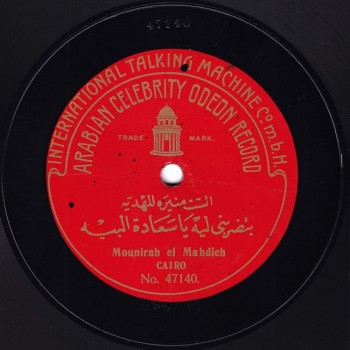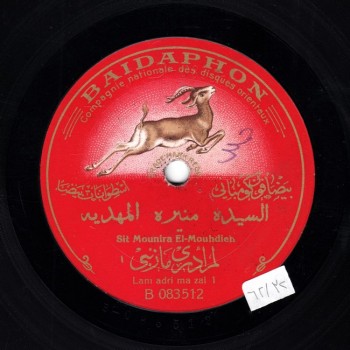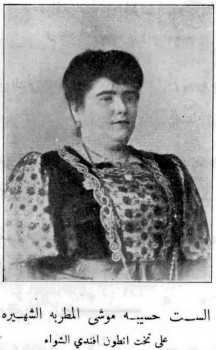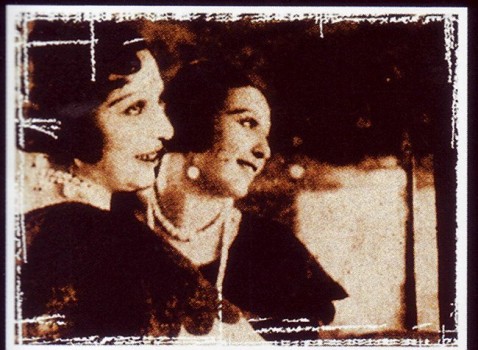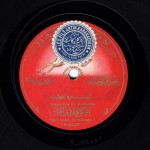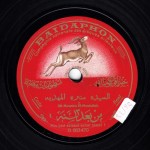The Arab Music Archiving and Research foundation (AMAR), in collaboration with the Sharjah Art Foundation (SAF), presents “Min al-Tārīkh”.
Dear listeners,
Welcome to a new episode of “Min al-Tārīkh”.
Today, we will resume our discussion about Sitt Munīra al-Mahdiyya with Prof. Frédéric Lagrange.
We had ended our previous episode with Munīra al-Mahdiyya’s early recordings made by Odeon and Zonophone, before Baidaphon in 1914.
Let us resume listening.
Shall we listen to another song that tackles the subject of precocious marriage?
The beautiful, courageous, and lustful –if I may say– ṭaqṭūqa “Tiḍrabnī lēh yā sa‘ādit el-Bēh?” (“Why are you hitting me, Sir?”), also performed by ‘ālima Ḥasība Moshēh who was either Syrian or Lebanese, Beiruti or Aleppan…
…Or Levantine, as there were no borders at the time.
Exactly.
We could compare the performance of Ḥasība Moshēh with Munīra al-Mahdiyya’s in her ‘ālima period.
Why not?
(♩)
Munīra al-Mahdiyya started her theatre career around 1916, according to various sources.
Things get complicated here: according to what I read, because the British had closed down theatres, and because ‘Azīz ‘Īd wanted to take revenge on Sheikh Salāma Ḥigāzī who had separated from him, he decided to give the latter’s role to Munīra al-Mahdiyya in the play “Ṣalāḥ al-Dīn al-Ayyūbī” where she would sing “In kuntu fī al-gaysh”.
This must have happened in 1916, yet there is a disc recorded by Baidaphon, whose number starts with 23…
…So probably recorded in 1914.
Surely in 1914, where she sang…
…“In kuntu fī al-gaysh”
“In kuntu fī al-gaysh”.
We may conclude that she had listened to Sheikh Salāma Ḥigāzī and decided to imitate him in a disc, until ‘Azīz ‘Īd appreciated her good interpretation of qaṣīda “In kuntu fī al-gaysh” and chose her to replace Ḥigāzī…?
I still do not know if she recorded this disc after performing the dawr in “Ṣalāḥ al-Dīn al-Ayyūbī” on stage, or before until ‘Azīz ‘Īd chose her to record it.
This story about taking revenge on Sheikh Salāma Ḥigāzī is far-fetched: he suffered from hemiplegia towards the end of his life and must have been unable to perform on stage. Furthermore many, starting with Munīra al-Mahdiyya herself, described her relationship with Salāma Ḥigāzī as a relationship with a father, so it sounds unlikely that she helped to take revenge on him. If she actually performed in “Ṣalāḥ al-Dīn al-Ayyūbī”, she must have done that with Salāma Ḥigāzī’s full knowledge.
Convincing logic.
Anyway, the revenge issue concerns ‘Azīz ‘Īd, not Munīra al-Mahdiyya.
On the other hand, you have brought to our attention that Sheikh Salāma suffered from hemiplegia and was thus unable, in 1916, to perform this dawr and, moreover, with the same mastery that characterized his interpretations in the early 20th century.
The point is that she dressed as a man and is said to be the first Muslim Egyptian woman to perform on a stage in Cairo in 1916.
It is also said that she was the first muṭriba to perform on a stage without a ḥijāb, or veil.
Exactly.
It seems that she masterfully interpreted all Salāma Ḥigāzī’s qaṣīda, including his takht qaṣīda and his theatre qaṣīda: Salāma Ḥigāzī’s theatre qaṣīda are mursala (without a fixed rhythm) while his takht qaṣīda are ‘ala al-waḥda.
I suggest we listen to an excerpt of Munīra al-Mahdiyya’s old version of qaṣīda “In kuntu fī al-gaysh” recorded in 1914…
(♩)
As for qaṣīda ‘ala al-waḥda –sometimes named “Āh yā anā” qaṣīda in the old catalogues–, there is a beautiful qaṣīda interpreted by Munīra al-Mahdiyya in her personal and somewhat strange style…
Let us listen to qaṣīda “Lam adri mā dhanbī” to the sikāh…
…Where she sings the original –maybe even the ‘ālima– version of the “ ‘Awādhil” melody.
In the original version to the sikāh…
As we know, dūlāb “al-‘awādhil” was initially a dawr that later, for unknown reasons, became the traditional introduction to the qaṣīda ‘ala al-waḥda.
Yes.
Munīra sings it in a purely ‘ālima fashion, then starts the qaṣīda.
The first particularity in this recording is that Munīra repeats the first hemistich much more than is usual in the performance of qaṣīda ‘ala al-waḥda, before reaching the second hemistich. The second particularity is her scansion of the lyrics. She has a tendency to stop in the middle of a word, to take a breath, then to resume the word. This scansion complies with ‘arūḍ. This does not imply though that she had any knowledge of or ability in ‘arūḍ.
It was unconscious.
Indeed. She understood ‘arūḍ by instinct, but her abiding by ‘arūḍ made her segment the verse in such a strange way that listeners might deduce that she could not understand the words. Moreover, her articulation clearly shows that she had not studied the Koran… that she did not belong to a religious circle.
True. The articulation of Wadūda al-Manyalāwiyya or Wadūda Badr, among others, is much better than Munīra al-Mahdiyya’s.
And later, Fatḥiyya Aḥmad and Umm Kulthūm.
Later on, yes of course.
So, one may think that she could not understand what she was saying in literary Arabic. We must then go back to the issue of whether Munīra al-Mahdiyya could read and write. It seems that she did go to school but that she missed classes a lot, according to an interview with her mentioned in Ratība al-Ḥifnī’s book.
Yet in my opinion, the point is beyond the issue of literary Arabic or colloquial Arabic, because this same strange scansion/segmentation present in her most famous ṭaqṭūqa “Asmar malak rūḥī”, i.e. in “Ta‘āla bil ‘aggal lil”..etc.
“Ta‘āla ta…‘āla ta…‘āla ta”.
Exactly. …This scansion/segmentation that overturns a word and empties it of any significance, this performance policy, also characterizes her interpretation of qaṣīda ‘ala al-waḥda.
I suggest we first listen to this qaṣīda ‘ala al-waḥda, then to her most famous ṭaqṭūqa “Asmar malak rūḥī” in order to compare both performances.
(♩)
What a beautiful qaṣīda!
With qaṣīda “Lam adri mā dhanbī” we reach the end of today’s episode of “Min al-Tārīkh”.
We thank Prof. Frédéric Lagrange.
We will meet again in a new episode to resume our discussion about Sitt Munīra al-Mahdiyya.
“Min al-Tārīkh” is brought to you by Mustafa Said.
- 221 – Zakariyya Ahmed – 12 (1/9/2022)
- 220 – Zakariyya Ahmed – 11 (1/9/2022)
- 219 – Zakariyya Ahmed – 10 (11/25/2021)
- 218 – Zakariyya Ahmed – 9 (10/26/2021)
- 217 – Zakariyya Ahmed – 8 (9/24/2021)
- 216 – Zakariyya Ahmed – 7 (9/4/2021)
- 215 – Zakariyya Ahmed – 6 (8/28/2021)
- 214 – Zakariyya Ahmed – 5 (8/6/2021)
- 213 – Zakariyya Ahmed – 4 (6/26/2021)
- 212 – Zakariyya Ahmed – 3 (5/27/2021)
- 211 – Zakariyya Ahmed – 2 (5/1/2021)
- 210 – Zakariyya Ahmed – 1 (4/28/2021)
- 209 – W-al-Lāhi lā astaṭī‘u ṣaddak 2 (4/6/2017)
- 208 – W-al-Lāhi lā astaṭī‘u ṣaddak 1 (3/30/2017)
- 207 – Bashraf qarah baṭāq 7 (3/23/2017)

